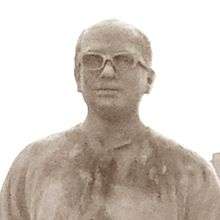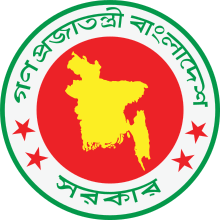Vice President of Bangladesh
The Vice-President of Bangladesh was formerly the second highest constitutional office in Bangladesh, when the country was governed under a presidential system. The Vice-President was the first person in the presidential line of succession, in the event of a President's resignation, removal or death. The post was held by several Bangladeshi statesmen during different periods of the country's history. The inaugural office holder was Syed Nazrul Islam during the Bangladesh Liberation War. The final office holder was Shahabuddin Ahmed. Abdus Sattar was the only vice-president to succeed to the presidency in 1981.
| Vice-President of the People's Republic of Bangladesh
গণপ্রজাতন্ত্রী বাংলাদেশের উপরাষ্ট্রপতি | |
|---|---|
 | |
| Style | The Honorable |
| Residence | Jamuna State House Hare Road, Ramna, Dhaka |
| Appointer | President of Bangladesh |
| Formation | 17 April 1971 |
| First holder | Syed Nazrul Islam |
| Final holder | Shahabuddin Ahmed |
| Abolished | 6 December 1990 |
 |
|---|
| This article is part of a series on the politics and government of Bangladesh |
|
Constitution and law
|
|
Government |
|
|
|
|
|
The office was first created in the Provisional Government of Bangladesh in 1971. It was later revived in 1977, abolished in the 1982 coup d'état; and reinstated in 1986. It was abolished again during the Twelfth Amendment to the Constitution.
Key
- Political parties
- Bangladesh Awami League
- Other factions
Vice-Presidents
| Name (Birth–Death) |
Portrait | Term | Party | President | Notes | |
|---|---|---|---|---|---|---|
| Syed Nazrul Islam (1925–1975) |
 |
1971–1972 | Bangladesh Awami League | Sheikh Mujibur Rahman | Acting President during the Bangladesh Liberation War.[1] | |
| Abdus Sattar (1906–1985) |
 |
1977–1981 | Bangladesh Nationalist Party | Ziaur Rahman | Succeeded Zia as president in 1981.[2] | |
| Mirza Nurul Huda (1919–1991) |
 |
1981–1982 | Independent | Abdus Sattar | Resigned after conflict with BNP.[3] | |
| Mohammad Mohammadullah (1921–1999) |
 |
1982 | Bangladesh Nationalist Party | In office for 24 hours; deposed in the 1982 coup d'état[4] | ||
| A. K. M. Nurul Islam (1919–2015) |
 |
1986–1989 | Jatiya Party | Hussain Muhammad Ershad | Former Supreme Court Justice and Law Minister.[5] | |
| Moudud Ahmed (1940–) |
 |
1989–1990 | Jatiya Party | Former Prime Minister and Deputy Prime Minister. | ||
| Shahabuddin Ahmed (1930–) |
 |
1990 | Independent | Former Chief Justice of Bangladesh. Served as Acting President after Ershad's resignation and led transitional government to the parliamentary period.[6] |
See also
References
- "A Political and Economic Dictionary of South Asia – Jivanta Schottli, Subrata K. Mitra, Siegried Wolf – Google Books". Books.google.com.bd. Retrieved 6 November 2015.
- Kolbert, Elizabeth (6 October 1985). "Abdus Sattar, Ex-Leader of Bangladesh, Dies". Bangladesh: NYTimes.com. Retrieved 6 November 2015.
- "Bangladesh: Past and Present – Salahuddin Ahmed – Google Books". Books.google.com.bd. Retrieved 6 November 2015.
- "Mohammadullah, Mohammad – Banglapedia". En.banglapedia.org. Retrieved 6 November 2015.
- Reuters (1 December 1986). "Vice President Named By Bangladesh Leader". Bangladesh: NYTimes.com. Retrieved 6 November 2015.
- "Seventy Years in a Shaky Subcontinent – Habibuz Zaman – Google Books". Books.google.com.bd. Retrieved 6 November 2015.

